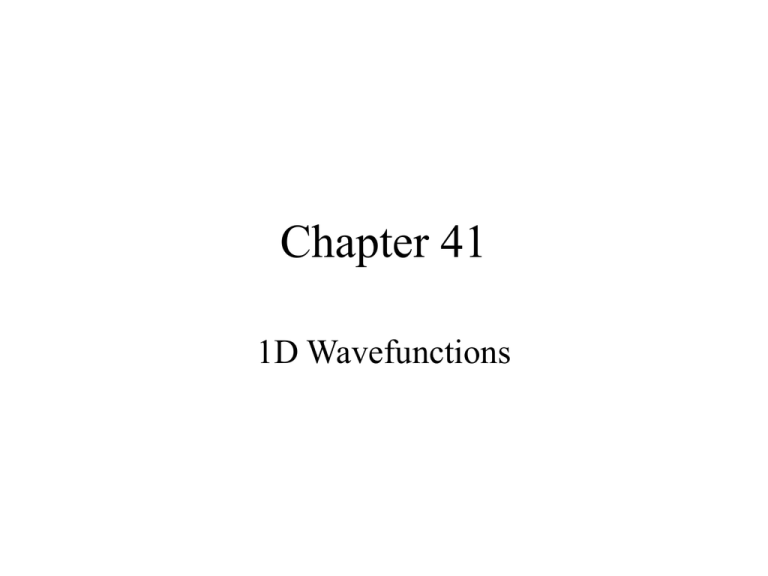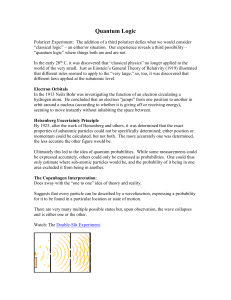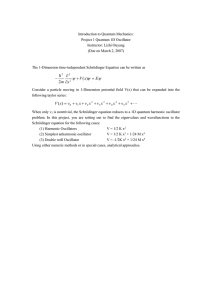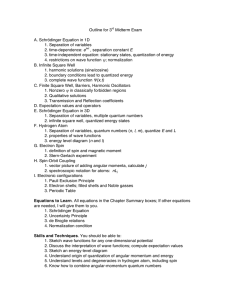Chapter41_VG.ppt
advertisement

Chapter 41 1D Wavefunctions Chapter 41. One-Dimensional Quantum Mechanics Topics: • Schrödinger’s Equation: The Law of Psi • Solving the Schrödinger Equation • A Particle in a Rigid Box: Energies and Wave Functions • A Particle in a Rigid Box: Interpreting the Solution • The Correspondence Principle • Finite Potential Wells • Wave-Function Shapes • The Quantum Harmonic Oscillator • More Quantum Models • Quantum-Mechanical Tunneling The wave function is complex. h2 2 ih (x,t) (x,t) U(x) (x,t) 2 t 2m x What is the PDF for finding a particle at x ? P(x,t) (x,t) 2 Step 1: solve Schrodinger equation for wave function Step 2: probability of finding particle at x is P(x,t) (x,t) 2 Stationary States - Bohr Hypothesis h2 2 ih (x,t) (x,t) U(x) (x,t) 2 t 2m x (x,t) ̂ (x)e1Et /h E h Stationary State satisfies h2 2 Ê (x) ̂ (x) U(x)̂ (x) 2 2m x Stationary states h2 2 Ê (x) ̂ (x) U(x)̂ (x) 2 2m x Rewriting: 2 2 ̂ (x) (x)̂ (x) 2 x Dependence on x comes from dependence on potential 2m (x) 2 E U(x) h 2 2 2 ̂ (x) (x)̂ (x) 2 x 2m (x) 2 E U(x) h 2 Classically E U(x) K K= kinetic energy Requirements on wave function 1. Wave function is continuous 2. Wave function is normalizable 2 2 ̂ (x) (x)̂ (x) 2 x 2 (x) 2m E U(x) 2 h 2m (x) 2 K h 2 2 2 ̂ (x) (x)̂ (x) 2 x 2m 2 (x) 2 E U(x) h 2m 2 (x) 2 K h For 2 2 ̂ (x) ̂ (x) 2 x 0<x<L ̂ (x) Asin x Bcos x Solution: Boundary Conditions: ̂ (0) 0 ̂ (L) 0 ̂ (0) 0 ̂ (0) Asin0 Bcos0 B B 0 L n ̂ (L) Asin L 0 n Must have ̂ (L) 0 2 2m 2 En h h2 2 h2 n En n 2m 2m L 2 Energy is Quantized A Particle in a Rigid Box The solutions to the Schrödinger equation for a particle in a rigid box are For a particle in a box, these energies are the only values of E for which there are physically meaningful solutions to the Schrödinger equation. The particle’s energy is quantized. A Particle in a Rigid Box The normalization condition, which we found in Chapter 40, is This condition determines the constants A: The normalized wave function for the particle in quantum state n is EXAMPLE 41.2 Energy Levels and Quantum jumps QUESTIONS: EXAMPLE 41.2 Energy Levels and Quantum jumps EXAMPLE 41.2 Energy Levels and Quantum jumps EXAMPLE 41.2 Energy Levels and Quantum jumps EXAMPLE 41.2 Energy Levels and Quantum jumps EXAMPLE 41.2 Energy Levels and Quantum jumps The Correspondence Principle • Niels Bohr put forward the idea that the average behavior of a quantum system should begin to look like the classical solution in the limit that the quantum number becomes very large—that is, as n ∞. • Because the radius of the Bohr hydrogen atom is r = n2aB, the atom becomes a macroscopic object as n becomes very large. • Bohr’s idea, that the quantum world should blend smoothly into the classical world for high quantum numbers, is today known as the correspondence principle. The Correspondence Principle As n gets even bigger and the number of oscillations increases, the probability of finding the particle in an interval x will be the same for both the quantum and the classical particles as long as x is large enough to include several oscillations of the wave function. This is in agreement with Bohr’s correspondence principle. 2 2 ̂ (x) (x)̂ (x) 2 x 2m 2 (x) 2 E U(x) h Between x=0 and x=L 2 (x) 0 Outside 2 (x) 0 Finite Potential Wells The quantum-mechanical solution for a particle in a finite potential well has some important properties: • The particle’s energy is quantized. • There are only a finite number of bound states. There are no stationary states with E > U0 because such a particle would not remain in the well. • The wave functions are qualitatively similar to those of a particle in a rigid box, but the energies are somewhat lower. • The wave functions extend into the classically forbidden regions. (tunneling) Finite Potential Wells The wave function in the classically forbidden region of a finite potential well is The wave function oscillates until it reaches the classical turning point at x = L, then it decays exponentially within the classically forbidden region. A similar analysis can be done for x ≤ 0. We can define a parameter η defined as the distance into the classically forbidden region at which the wave function has decreased to e–1 or 0.37 times its value at the edge: 2 2 ̂ (x) (x)̂ (x) 2 x 2m 2 (x) 2 E U(x) h Outside 2 (x) 0 2 1 ̂ (x) 2 ̂ (x) 2 x 1 2m 2 U 0 E 2 h Solution, x>L ̂ (x) ̂ edge exp[(x L) / ] The Quantum Harmonic Oscillator The potential-energy function of a harmonic oscillator, as you learned in Chapter 10, is where we’ll assume the equilibrium position is xe = 0. The Schrödinger equation for a quantum harmonic oscillator is then The Quantum Harmonic Oscillator The wave functions of the first three states are Where = (k/m)1/2 is the classical angular frequency, and n is the quantum number Quantum-Mechanical Tunneling Once the penetration distance is calculated using 1 2m 2 U 0 E 2 h probability that a particle striking the barrier from the left will emerge on the right is found to be THE END ! Good Luck on the remaining exams







